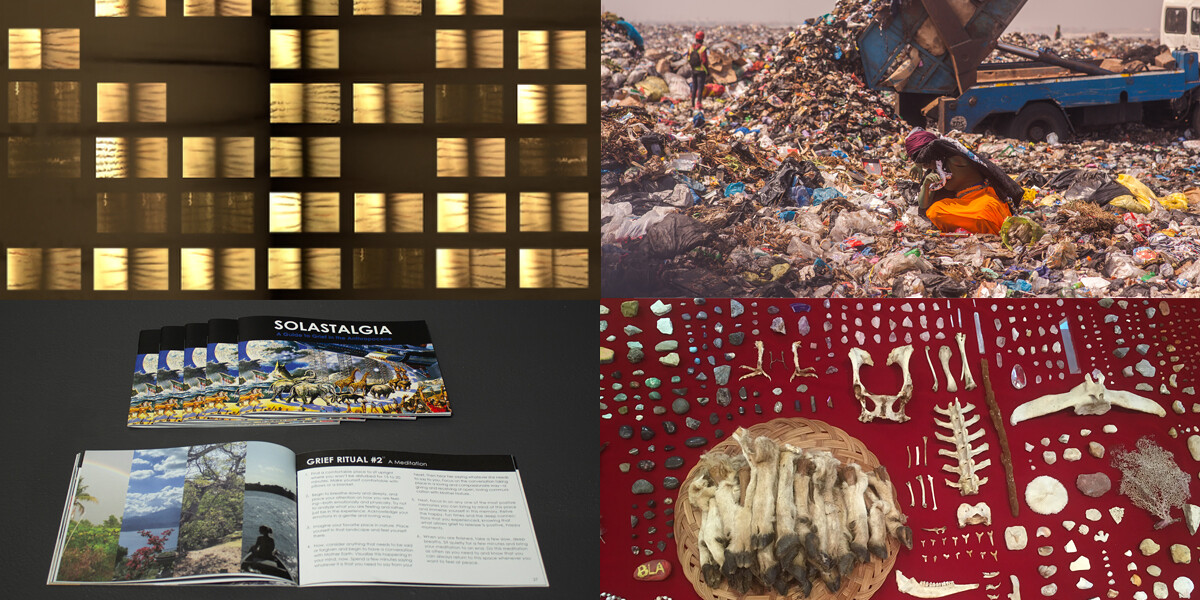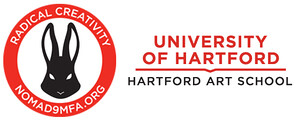200 Bloomfield Ave.
06117 West Hartford CT
In June, 2019 the Hartford Art School exhibited the thesis projects of Zahar Al-Dabbagh from Saudi Arabia, Fatric Bewong of Ghana, and US artists Blair Butterfield and Sophy Tuttle in The Art of Engagement: Regeneration as Practice. In an excerpt from the exhibition catalogue, faculty Mary Mattingly writes, “The artists in Cohort Two have thrived in this community while grappling with topics surrounding consumption, grief, magic, spirituality, the Anthropocene, and the Commons. They build worlds, reorganize tools, and displace systemic expectations while transforming overlooked objects in order to revalue them.”
Zahar Al-Dabbagh is an artist who lives between the United States and the Middle East. Zahar’s work, Unearthed, Unanswered, Unknown, is driven by her relationships between these two places that are so different but intertwined, and by political and cultural change in the Middle East. Through video collage and sculptural installation, Zahar communicates the cyclicality of death and rebirth, and asks viewers to read between the lines in order to carefully consider the objects she confronts us with. Through layering her own text over culturally embedded texts in an act that is akin to palimpsest writing or Derridan sous rature, Zahar embeds multilayered messaging into the preexisting cultural doctrine.
In Some Requiems for Land, Sea and Sky, Fatric Bewong asks us to visit a landfill, breathe the surrounding air, listen to the objects living there, and ask ourselves, do these toxic spaces need to exist? And what is the power of a Thing in a vast sea of discarded things? Would many of us consume in the same ways if we shared the experience of visiting this forgotten space? Fatric sculpts with reused materials with the intention to revalue them as formal objects, colorful and plentiful, sublime in their potential scale and scope. For all of its perceived temporary conveniences, Fatric maintains that we do not need to inherit the destructive legacy of capital accumulation, and that art can accompany a re-telling of the present day by insisting on a deep generosity and reciprocity through maintenance, reuse, and revaluing the things cultures have deemed valueless.
In the words of artist Blair Butterfield, art making is part of a “Curative Culture.” Blair is not satisfied with diagnosing societal problems, but is seeking means for her art to actively challenge and change destruction caused by extraction. Blair’s work Chasing Magic combines her life experiences farming and co-building cooperative spaces with a personal journey through forms of spiritual and social healing. This body of work is comprised of field notes, photographic “plant portraits,” collected objects, and animate objects that transformed though the course of the exhibition, as Blair continues her journey of co-learning and co-creating to be a better steward of the Commons.
Sophy Tuttle developed the work Solastalgia (a term coined by philosopher and professor of sustainability Glenn Albrecht) to describe both the cause and effect of the Sixth Extinction on the earth’s inhabitants. Sophy’s holistic approach to making art accompanies the more narrow and specialized scientific viewpoints that she draws on in creating her sculptural installation. The monument is made of 176 boxes containing images and evidence of the approximately 176 species a day who become extinct due to human interventions into land and habitat, as well as the volatile effects of rapid climate change. While we live under economic systems that externalize costs, Sophy’s work reminds us that we need to find ethical ways for art to expand our collective potentials for transformation. She’s starting that process with a monument that both celebrates the lives of endangered beings while mourning those lost.
Founded in 2015 by Carol Padberg, more information about the field-based Nomad/9 MFA can be found at nomad9mfa.org. Follow the program’s upcoming October 2019 residency in Oaxaca, Mexico through daily Instagram posts. The scholarship deadline to apply for Cohort Five is February 1, 2020.
*Image above: Top left: Zahar Al-Dabbagh, A Thousand and (One) Question (still), 2019. Video collage and soundscape. Top right: Fatric Bewong, The Visitation of Asaase Yaa (still), 2019. Single channel video of four looped sequences with sound and color, 7 minutes. Bottom left: Sophy Tuttle, Solastalgia: A Guide to Grief in the Anthropocene, 2019. Recycled paper. Bottom right: Blair Butterfield, Chasing Magic: Objects of Magic (detail), 2019. Red velvet, glass jars, sewing kit, wooden bird call, flute, feathers, shells, bones, sheep feet, corn husks, dried corn, baskets, seeds, dried plants, tin can, wood boxes, resin, sticks, stones, crystals, and other natural objects.



